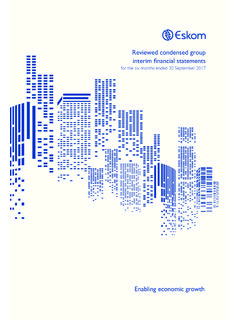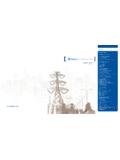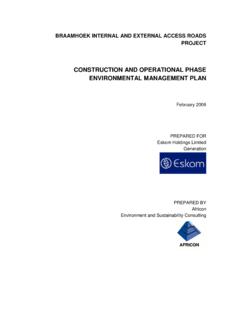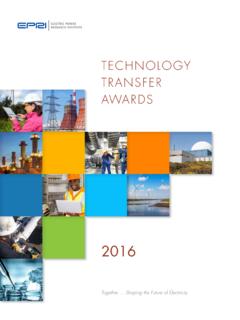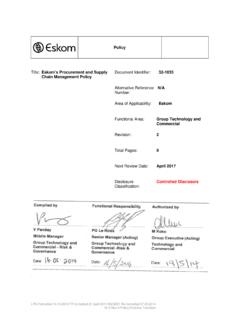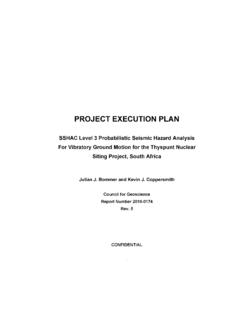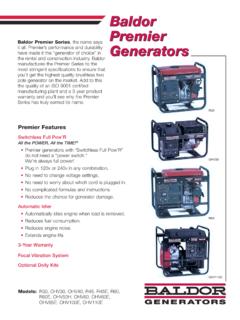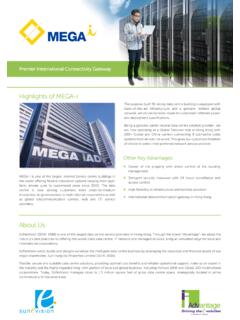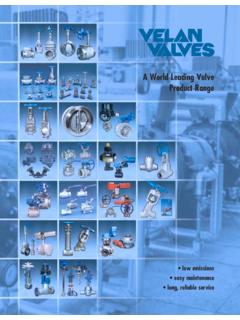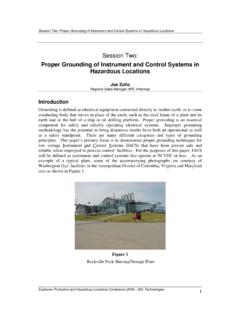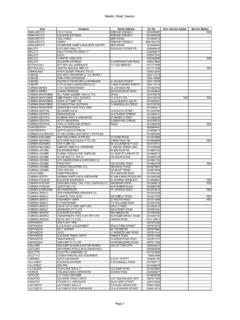Transcription of Medupi Power Station Project - Eskom
1 1 Medupi Power Station Project February 2014 Medupi is a greenfield coal-fired Power plant Project located west of Lephalale, Limpopo Province, South Africa. Medupi is the fourth dry-cooled, baseload Station built in 20 years by Eskom after Kendal, Majuba and Matimba Power stations. The name Medupi is a Sepedi word which means rain that soaks parched lands, giving economic relief . The Power Station will be the fourth largest coal plant in the southern hemisphere, and will be the biggest dry-cooled Power Station in the world. The boiler and turbine contracts for Medupi are the largest contracts that Eskom has ever signed in its 90-year history. The planned operational life of the Station is 50 years. Why in Lephalale? Eskom undertook screening and feasibility studies in order to determine the most viable plant location option for Medupi Power Station .
2 Assessment criteria included: availability and accessibility of primary resources, such as water and coal ability of the new Power Station to connect to the existing Eskom network/grid environmental acceptability cost of production. Eskom ranked the Waterberg Coalfields and the Lephalale area in the vicinity of the existing Matimba Power Station as the most favourable option for the establishment of a new coal-fired Power Station due to inter alia: land availability in close proximity to the primary coal source properties of coal in the area are well known due to the experience acquired through the existing Matimba Power Station competitive coal prices low environmental impact on the chosen site 2 Technical information The new Power Station will comprise of six units with a gross nominal capacity of 800MW each, resulting in a total capacity of 4 800 MW.
3 Construction activities commenced in May 2007, with the first of the six units of the Power plant planned for first Power by the end of 2014. In an effort to improve efficiency of the Station , supercritical boilers and turbines will be installed. These operate at higher temperatures and pressures than Eskom s other stations. This baseload Station will also use direct dry-cooling due to the water scarcity in the area. Interesting facts - More steel is used than the world s tallest building (the Burj in Dubai) - some 20 200 tons of structural steel was used for the Unit 6 boiler construction. The overall forecast is 120 000 tons of structural steel for all six units. - The Project uses enough concrete to build four Greenpoint Stadiums. Parts and cement weighing the same as seven super tankers that need to be transported over land the total distance to transport materials to site is equivalent to 20 times around the world.
4 In excess of million m3 of concrete has been placed on site by October 2013. Medupi also has the largest concrete batching facility in South Africa. - The Medupi boiler house will stand approximately 130 meters in height, equivalent to Sandton City. - Job creation is expected to peak at 17 000 direct jobs during construction. - The town of Lephalale s gross domestic product has increased by about 95% per year as a result of the construction activities. - The Power Station will directly grow SA s GDP by approximately per year. - About 50% of the Project cost is committed and spent locally. - 22 340 meals are prepared and served daily. - The 800 ton crane used in the boiler construction area has a boom that can reach 140 m; which is higher than the Sandton City Tower. - The highest point on site is the top of the chimney 220 m.
5 - Improved environmental performance due to air-cooled condensors, lower water usage, air bag filters, low NO2 burners and supercritical boilers The uniqueness of this Project lies in the fact that Medupi is being built backwards - traditionally Eskom has always started building Unit 1 and ended with Unit 6. This new approach is the result of the rock conglomeration on the southern side which is excavated and reused as the engineering fill on the northern side. Construction milestones The environmental impact assessment for this Station was undertaken and a positive record of decision was issued by the Department of Environmental Affairs and Tourism in 2006. The Minister of Environmental Affairs and Tourism considered the appeals lodged against the decision, and confirmed the positive record of decision at the beginning of May 2007.
6 The official sod-turning ceremony was held at the construction site on 14 August 2007. The then Minister of Public Enterprises, Mr Alec Erwin, and the Premier of Limpopo Province, Mr Sello Moloto, were in attendance. Medupi terracing work done by Roshcon commenced in May 2007. The Medupi first civil concrete pouring took place on 18 July 2008. The first air cooled condenser concrete slip forming started on 31 October 2008. 3 - First structural concrete poured on site 18 July 2008. - First three air-cooled condenser columns completed 21 November 2008. - Unit 6 boiler lift shaft completed August 2009. - First structural steel erection on Unit 6 boiler 9 February 2010. - First chimney completed at a height of 220m 12 August 2010. - Unit 6 generator stator in position 23 June 2010. - Unit 6 turbine table handed over 7 February 2011.
7 - The 10 000 ton coal silo complete 8 September 2011. - Auxiliary boiler complete 21 November 2011. - Direct-current supplies energised 10 February 2012. - The Project commenced the first 24-hour performance testing to run at maximum capacity for the delivery of coal to Medupi from the Grootegeluk mine - 27 November 2012 - September 2013: The Unit 4 generator motor was threaded into the stator. This action requires precision as the clearance is only a few millimeters. All stationary equipment between the rotor and the stator can now be fitted and the generator coupled to the LP2 rotor - September 2013: The wet run of the submerged scraper conveyer was successfully completed. This system removes the ash from the bottom of the boiler another essential step in getting the boiler ready for first fire - January 2014: The boiler separators which were initially installed for Unit 6 have sucessfully been cut out.
8 The new replacement separators will now be installed. The purpose of the separators is to separate the steam and steam water droplets. - February 2014: Following close co-operation between Team Medupi and the contractors all boiler issues have been resolved, which allowed for the installation of the Boiler Frame for Unit 1 to commence. - 10 February 2014: back energising of Unit 6 generator and Unit Transformers via the distributed control system Environmental facts The site was formerly the farm Naauw Ontkomen and was bought from Kumba Coal (Pty) Ltd - now known as Exxaro Coal (Pty) Ltd. The site measures 883 hectares and was previously used for peanut crops, game and cattle grazing. A thorough environmental approach was followed from the start of construction in 2007.
9 During the clearing of the site many environmental factors were highlighted. A visual beacon on the site was a baobab tree which is believed to be a few hundred years old. The team immediately made plans to preserve this beautiful tree. A lengthy process was put in place to relocate it and plant it where the entrance to the Power Station would ultimately be. It was pruned before moving, including a 10-day preparation for transplanting. The aim was to keep the tree as a 3-stem unit for aesthetic purposes. This involved cranes and a truck being employed to move the tree and replant it, under the guidance of a tree expert. On 23 July 2011 a second baobab tree was relocated from the ash dump area to the main entrance area. Apart from this baobab, many nationally and provincially protected trees were either replanted or transported to a special nursery at the adjacent Matimba Power Station .
10 This included species such as camel thorns, shepherds trees, leadwoods, tamboti and marulas. Not only trees are being cared for but some game as well. Some 30 to 40 animals have been relocated to an Eskom game reserve close by during the site clearance and approximately 50 remain which will be managed as part of the ecosystem after construction is complete. 4 There is also a programme to catch and relocate all snakes, reptiles and problem animals found on site by a local professional snake catcher, including educational talks with caught snakes to workers. 1 293 reptiles have been removed from site since 2007, which includes: rock-and water monitors, tortoises, terrapins, chameleons, scorpions, venomous and non-venomous snakes, baboon spiders Augacephalus junodi and burst horned baboon spiders Ceratogyrus darlingi, and serval (Leptailurus serval).

